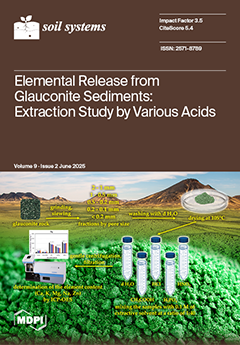Straw return enhances soil biological properties by increasing carbon and energy availability, thereby improving conditions for microbial communities. However, the introduction of beneficial bacteria, such as
Bacillus subtilis, can further shape the rhizosphere bacterial composition. In this study, we combined sugarcane straw
[...] Read more.
Straw return enhances soil biological properties by increasing carbon and energy availability, thereby improving conditions for microbial communities. However, the introduction of beneficial bacteria, such as
Bacillus subtilis, can further shape the rhizosphere bacterial composition. In this study, we combined sugarcane straw return with
B. subtilis inoculation to test whether this synergy reduces microbial specialization in the sugarcane rhizosphere. Three treatments were evaluated: (I) bulk soil (bulk), (II) rhizosphere soil with straw return but no
B. subtilis inoculation (straw), and (III) rhizosphere soil with straw return and
B. subtilis inoculation (straw + Bacillus). The bacterial community, including plant-growth-promoting bacteria (PGPB), was analyzed via 16S rRNA amplicon sequencing. Neither straw return nor
B. subtilis inoculation significantly altered bacterial richness, diversity, or phylum-level abundance in the rhizosphere. Actinobacteria, Firmicutes, and Proteobacteria dominated the community, with
Bacillus,
Bradyrhizobium, and
Paenibacillus as the predominant PGPB genera. Notably, only
Bradyrhizobium abundance increased in the rhizosphere when straw was co-applied with
B. subtilis. A co-occurrence network analysis revealed stronger microbial interactions under straw return, while
B. subtilis enhanced connectivity among the PGPB. Although niche occupancy remained stable, PGPB specialization was higher with straw alone, suggesting that
B. subtilis fosters a more generalist community. In conclusion, while straw return and
B. subtilis inoculation did not affect overall bacterial diversity,
B. subtilis increased PGPB interactions and reduced functional specialization, promoting a more generalized microbial community.
Full article





